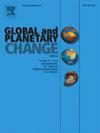Consistency and environmental variability in mineral–organic interactions: The role of illite in organic carbon preservation in the northern South China Sea
IF 4
1区 地球科学
Q1 GEOGRAPHY, PHYSICAL
引用次数: 0
Abstract
Mineral–organic matter interactions are globally recognized as a primary control on the long-term preservation of sedimentary organic carbon (OC). By integrating new ramped pyrolysis/oxidation (RPO) data from the northern South China Sea (SCS) with datasets from global fjords, estuaries, and marine systems, we confirm a consistent inverse relationship between OC content and both mean activation energy (μE) and bond diversity (σE), reinforcing the thermodynamic signature of mineral-associated OC preservation. However, SCS sediments reveal a key deviation: σE in the SCS positively correlates with low-E OC fractions, in contrast to global patterns, suggesting that mineral interactions in this setting preferentially stabilize thermally labile components. We further show that illite, the dominant clay mineral in the SCS, correlates with broader σE and lower μE, consistent with its role in retaining OC across a thermally diverse spectrum. While smectite is often cited as more protective, it is scarce in this region and shows no significant correlation with RPO parameters. Spatial trends also highlight the importance of OC source: a unique terrestrial-influenced site (BC15) exhibits elevated thermal stability and low low-E OC fractions, likely due to the intrinsic recalcitrance of vascular plant-derived material rather than mineral protection. Our findings demonstrate that while mineral–OC interactions are globally consistent in their role, their expression is modulated by sediment mineralogy, OC sources, and depositional settings. This underscores the importance of combining thermal reactivity metrics with mineralogical context to resolve the mechanisms underpinning OC preservation.
矿物-有机相互作用的一致性和环境变异性:南海北部伊利石在有机碳保存中的作用
矿物-有机质相互作用是沉积物有机碳长期保存的主要控制因素。通过整合来自南海北部地区的新斜坡热解/氧化(RPO)数据与全球峡湾、河口和海洋系统的数据,我们证实OC含量与平均活化能(μE)和键多样性(σE)之间存在一致的反比关系,强化了矿物相关OC保存的热力学特征。然而,南海沉积物显示出一个关键偏差:与全球模式相反,南海沉积物的σE与低e OC组分正相关,表明该环境下矿物相互作用优先稳定热不稳定组分。我们进一步发现,伊利石是南海中主要的粘土矿物,其σE较宽,μE较低,这与它在不同热谱上保持OC的作用一致。虽然蒙脱石通常被认为具有更强的保护作用,但它在该地区很稀少,并且与RPO参数没有显着相关性。空间趋势也突出了OC来源的重要性:一个独特的受陆地影响的地点(BC15)表现出较高的热稳定性和较低的低e OC分数,可能是由于维管植物来源材料的内在顽固性,而不是矿物保护。我们的研究结果表明,虽然矿物与OC的相互作用在全球范围内是一致的,但它们的表达受到沉积物矿物学、OC来源和沉积环境的调节。这强调了将热反应性指标与矿物学背景相结合以解决支撑OC保存机制的重要性。
本文章由计算机程序翻译,如有差异,请以英文原文为准。
求助全文
约1分钟内获得全文
求助全文
来源期刊

Global and Planetary Change
地学天文-地球科学综合
CiteScore
7.40
自引率
10.30%
发文量
226
审稿时长
63 days
期刊介绍:
The objective of the journal Global and Planetary Change is to provide a multi-disciplinary overview of the processes taking place in the Earth System and involved in planetary change over time. The journal focuses on records of the past and current state of the earth system, and future scenarios , and their link to global environmental change. Regional or process-oriented studies are welcome if they discuss global implications. Topics include, but are not limited to, changes in the dynamics and composition of the atmosphere, oceans and cryosphere, as well as climate change, sea level variation, observations/modelling of Earth processes from deep to (near-)surface and their coupling, global ecology, biogeography and the resilience/thresholds in ecosystems.
Key criteria for the consideration of manuscripts are (a) the relevance for the global scientific community and/or (b) the wider implications for global scale problems, preferably combined with (c) having a significance beyond a single discipline. A clear focus on key processes associated with planetary scale change is strongly encouraged.
Manuscripts can be submitted as either research contributions or as a review article. Every effort should be made towards the presentation of research outcomes in an understandable way for a broad readership.
 求助内容:
求助内容: 应助结果提醒方式:
应助结果提醒方式:


